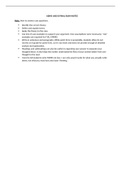Class notes
ADMS1000 Final Exam notes
- Institution
- York University (Ebor )
The Exam notes for ADMS1000: explains key terms, elaborates on the different business approaches, industry life cycle model, and political as well as government involvement in the corporate world.
[Show more]



